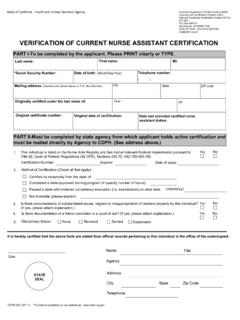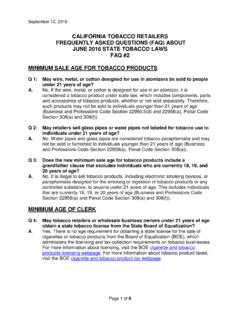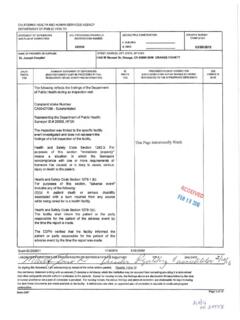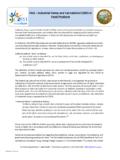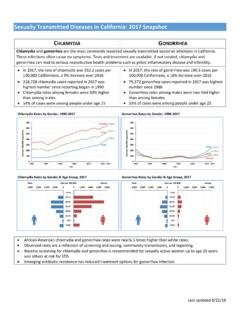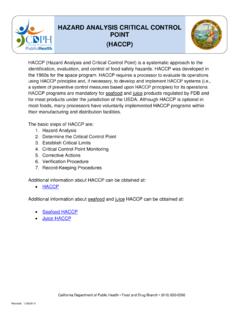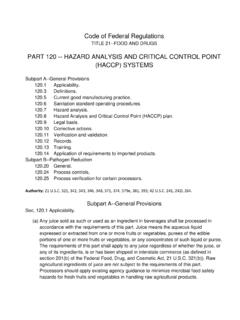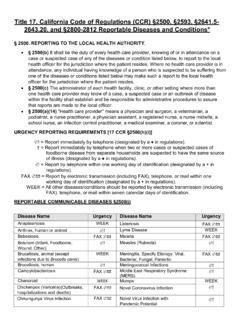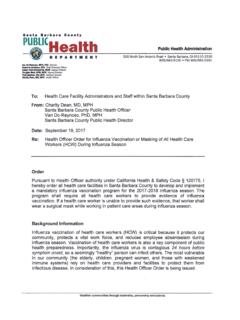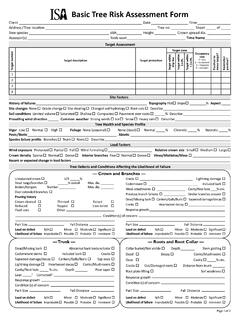Transcription of California Pediatric Tuberculosis Risk Assessment and User …
1 Dec 2017 California Tuberculosis Risk Assessment Pediatrics Use this tool to identify asymptomatic children for latent TB infection (LTBI) testing. Do not repeat testing unless there are new risk factors since the last negative initial negative screening test occurred prior to 6 months of age, repeat testing should occur at age 6 months or older Do not treat for LTBI until active TB disease has been excluded:For children with TB symptoms or abnormal chest x-ray consistent with active TB disease, evaluate for active TB disease with achest x-ray, symptom screen, and if indicated, sputum AFB smears, cultures and nucleic acid amplification negative tuberculin skin test or interferon gamma release assay does not rule out active TB testing is recommended if any of the 3 boxes below are checked. Birth, travel, or residence in a country with an elevated TB rate for at least 1 month Includes any country other than the United States, Canada, Australia, New Zealand, or a country in western or northernEurope Interferon Gamma Release Assay is preferred over Tuberculin Skin Test for foreign-born persons 2 years old Immunosuppression, current or plannedHIV infection, organ transplant recipient, treated with TNF-alpha antagonist ( , infliximab, etanercept, others), steroids(equivalent of prednisone 2 mg/kg/day, or 15 mg/day for 2 weeks) or other immunosuppressive medication Close contact to someone with infectious TB disease during lifetimeTreat for LTBI if LTBI test result is positive and active TB disease is ruled out.
2 None; no TB testing is indicated at this Name: _____ Date of Birth: _____ Provider Name: _____ Assessment Date: _____ See the Pediatric TB Risk Assessment User Guide for more information about using this tool. To ensure you have the most current version, go to the RISK Assessment page at: 1 Dec 2017 California Pediatric TB Risk Assessment User GuideAvoid testing persons at low risk Routine testing of low risk populations is not recommended and may result in unnecessary evaluations and treatment because of falsely positive test results. Local recommendations, mandated testing and other risk factors Several risk factors for TB that have been used to select children for TB screening historically or in mandated programs are not included among the 4 components of this risk Assessment . This is purposeful in order to focus testing on children at highest risk. However, certain populations may be mandated for testing by statute, regulation, or policy.
3 This risk Assessment does not supersede any mandated testing. Testing can also be considered in children with frequent exposure to adults at high risk of TB infection, such as those with extensive foreign travel in areas with high TB rates. Local recommendations should also be considered in testing decisions. Local TB control programs and clinics can customize this risk Assessment according to local recommendations. Providers should check with local TB control programs for local recommendations. Most Patients with LTBI should be treated Because testing of persons at low risk of TB infection should not be done, persons that test positive for LTBI should generally be treated once active TB disease has been ruled out with a physical exam, chest radiograph and, if indicated, sputum smears, cultures, and nucleic acid amplification testing(NAAT).
4 However, clinicians should not be compelled to treat low risk persons with a positive test for LTBI. When to repeat a risk Assessment and testing Risk assessments should be completed on new patients, patients thought to have new potential exposures to TB since last Assessment , and during routine Pediatric well-child visits. Repeat risk assessments should be based on the activities and risk factors specific to the child. High-risk children who volunteer or work in health care settings might require annual testing and should be considered separately. Re-testing should only be done in persons who previously tested negative and have new risk factors since the last Assessment (unless they were <6 months of age at the time of testing). In general new risk factors would include new close contact with an infectious TB case or new immunosuppression, but could also include foreign travel.
5 Immunosuppression The exact level of immunosuppression that predisposes to increased risk for TB progression is unknown. The threshold of steroid dose and duration used here are based on data in adults and in accordance with ACIP recommendations for live vaccines in children receiving immunosuppression. Foreign travel or residence Travel or residence in countries with an elevated TB rate may be a risk for TB exposure in certain circumstances ( , extended duration, likely contact with persons with infectious TB, high prevalence of TB in travel location, non-tourist travel). The duration of at least 1 consecutive month to trigger testing is intended to identify travel most likely to involve TB exposure. TB screening tests can be falsely negative within the 8 weeks after exposure, so are best obtained 8 weeks after a child s return. IGRA preference in foreign-born children 2 years old Because IGRA has increased specificity for TB infection in children vaccinated with BCG, IGRA is preferred over the tuberculin skin test for foreign-born children 2 years of age.
6 IGRAs can be used in children <2 years of age, however, there is an overall lack of data in this age group, which complicates interpretation of test results. In BCG vaccinated immunocompetent children with a positive TST, it may be appropriate to confirm a positive TST with an IGRA. If IGRA is not done the TST result should be considered the definitive result. Negative test for LTBI does not rule out active TB It is important to remember that a negative TST or IGRA result does not rule out active TB disease . A negative TST or IGRA in a patient with active TB disease can be a sign of extensive disease. Any suspicion for active TB disease or extensive exposure to TB should prompt an evaluation for active TB disease, including physical exam, symptom review, and 2-view chest x-ray. Emphasis on short course for treatment of LTBI Shorter regimens for treating latent TB infection have been shown to be as effective as 9 months of isoniazid, and are more likely to be completed.
7 Use of these shorter regimens is preferred in most patients, although the 12 week regimen is not recommended for children <2 years of age, children on antiretroviral medications, or pregnant adolescents. Drug-drug interactions and contact to drug resistant TB are other contra-indications for shorter regimes. Medication Frequency Duration Rifampin Daily 4 months Isoniazid + rifapentine* Weekly 12 weeks** *The CDC currently recommends DOT for this regimen; however, datahas shown that SAT is noninferior to DOT in the United States. Manyclinicians are using SAT or modified DOT.**11-12 doses in 16 weeks required for completion. 2 Dec 2017 California Pediatric TB Risk Assessment User Guide continued Refusal of recommended LTBI treatment Refusal should be documented. Recommendations for treatment should be made at future encounters with medical services. If treatment is later accepted, TB disease should be excluded and CXR repeated if it has been more than 3 months from the initial evaluation.
8 Symptoms that should trigger evaluation for active TB Patients with any of the following symptoms that are otherwise unexplained should be evaluated for active TB disease: cough for more than 2-3 weeks, fevers, night sweats, weight loss, lymphadenopathy, hemoptysis or excessive fatigue. Treatment Regimen Fact Sheets: Isoniazid/Rifapentine: American Academy of Pediatrics, Red Book Online, Tuberculosis : ACIP= Advisory Committee on Immunization Practices; LTBI=latent TB infection; IGRA= Interferon gamma release assay ( , QuantiFERON-TB Gold, ); BCG=Bacillus Calmette-Gu rin; TST= tuberculin skin test; DOT=Directly observed therapy; CXR=chest x-ray To ensure you have the most current version, go to the RISK Assessment page at

